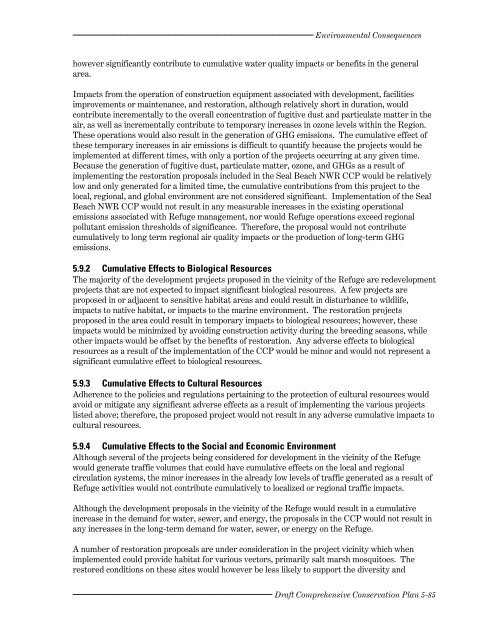Chapters 1 - U.S. Fish and Wildlife Service
Chapters 1 - U.S. Fish and Wildlife Service
Chapters 1 - U.S. Fish and Wildlife Service
Create successful ePaper yourself
Turn your PDF publications into a flip-book with our unique Google optimized e-Paper software.
Environmental Consequences<br />
however significantly contribute to cumulative water quality impacts or benefits in the general<br />
area.<br />
Impacts from the operation of construction equipment associated with development, facilities<br />
improvements or maintenance, <strong>and</strong> restoration, although relatively short in duration, would<br />
contribute incrementally to the overall concentration of fugitive dust <strong>and</strong> particulate matter in the<br />
air, as well as incrementally contribute to temporary increases in ozone levels within the Region.<br />
These operations would also result in the generation of GHG emissions. The cumulative effect of<br />
these temporary increases in air emissions is difficult to quantify because the projects would be<br />
implemented at different times, with only a portion of the projects occurring at any given time.<br />
Because the generation of fugitive dust, particulate matter, ozone, <strong>and</strong> GHGs as a result of<br />
implementing the restoration proposals included in the Seal Beach NWR CCP would be relatively<br />
low <strong>and</strong> only generated for a limited time, the cumulative contributions from this project to the<br />
local, regional, <strong>and</strong> global environment are not considered significant. Implementation of the Seal<br />
Beach NWR CCP would not result in any measurable increases in the existing operational<br />
emissions associated with Refuge management, nor would Refuge operations exceed regional<br />
pollutant emission thresholds of significance. Therefore, the proposal would not contribute<br />
cumulatively to long term regional air quality impacts or the production of long-term GHG<br />
emissions.<br />
5.9.2 Cumulative Effects to Biological Resources<br />
The majority of the development projects proposed in the vicinity of the Refuge are redevelopment<br />
projects that are not expected to impact significant biological resources. A few projects are<br />
proposed in or adjacent to sensitive habitat areas <strong>and</strong> could result in disturbance to wildlife,<br />
impacts to native habitat, or impacts to the marine environment. The restoration projects<br />
proposed in the area could result in temporary impacts to biological resources; however, these<br />
impacts would be minimized by avoiding construction activity during the breeding seasons, while<br />
other impacts would be offset by the benefits of restoration. Any adverse effects to biological<br />
resources as a result of the implementation of the CCP would be minor <strong>and</strong> would not represent a<br />
significant cumulative effect to biological resources.<br />
5.9.3 Cumulative Effects to Cultural Resources<br />
Adherence to the policies <strong>and</strong> regulations pertaining to the protection of cultural resources would<br />
avoid or mitigate any significant adverse effects as a result of implementing the various projects<br />
listed above; therefore, the proposed project would not result in any adverse cumulative impacts to<br />
cultural resources.<br />
5.9.4 Cumulative Effects to the Social <strong>and</strong> Economic Environment<br />
Although several of the projects being considered for development in the vicinity of the Refuge<br />
would generate traffic volumes that could have cumulative effects on the local <strong>and</strong> regional<br />
circulation systems, the minor increases in the already low levels of traffic generated as a result of<br />
Refuge activities would not contribute cumulatively to localized or regional traffic impacts.<br />
Although the development proposals in the vicinity of the Refuge would result in a cumulative<br />
increase in the dem<strong>and</strong> for water, sewer, <strong>and</strong> energy, the proposals in the CCP would not result in<br />
any increases in the long-term dem<strong>and</strong> for water, sewer, or energy on the Refuge.<br />
A number of restoration proposals are under consideration in the project vicinity which when<br />
implemented could provide habitat for various vectors, primarily salt marsh mosquitoes. The<br />
restored conditions on these sites would however be less likely to support the diversity <strong>and</strong><br />
Draft Comprehensive Conservation Plan 5-85

















